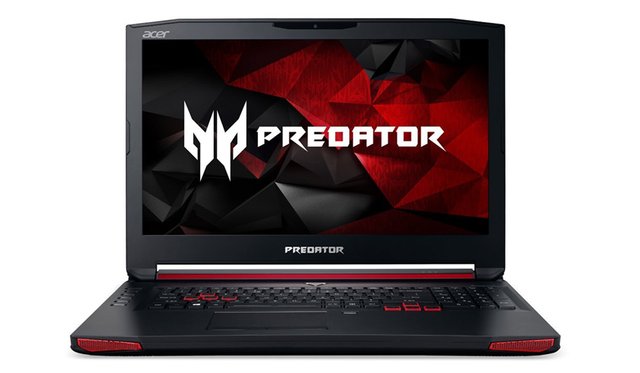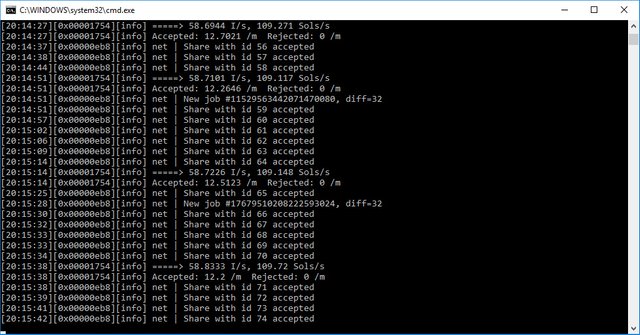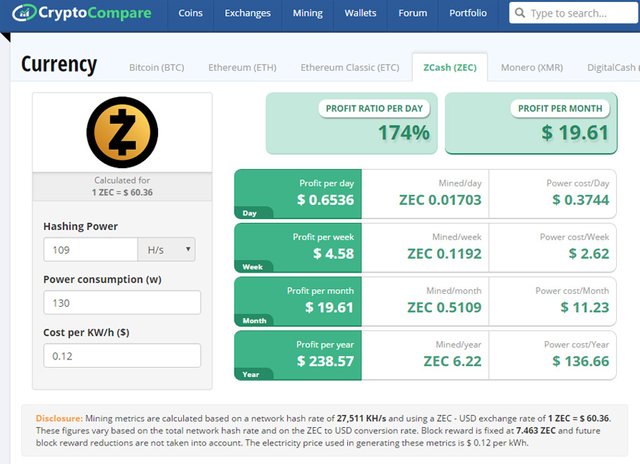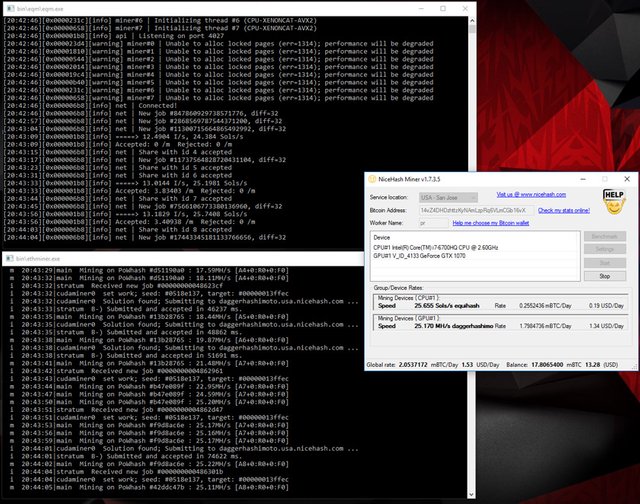
Thought that I should do a quick update on the post Buying a Gaming Laptop and Mining With It, So It Can Pay Back for Itself Over Time from about two weeks ago with some more up to date data to reflect the current situation. Things have changed a bit with new faster Zcash miners becoming available, the Zcash block reward increasing as well as the total network hashrate and the overall profit getting lower. Of course I will get some numbers to show you what you can expect to get at the moment to get you a better idea with the Acer Predator gaming laptop using Intel Core i7 6700HQ CPU and Nvidia GeForce GTX 1070 GPU...

Using the latest EQM miner for Zcash by NiceHash to mine on the GTX 1070 video card we are getting about 109 H/s in terms of performance. Unfortunately the AMD camp is getting much more optimized miners at the moment and the performance that AMD-based video cards, even older ones is significantly faster on Zcash. This essentially makes ZEC mining on NVidia GPUs at the moment not so great idea and is most likely also not the most profitable mining algorithm to go for...

Checking the results of the ZEC mining calculator on Cryptocompare confirm my suspicion that Zcash mining on the GTX 1070 is probably not that profitable already. Actual profit is at about $0.65 USD per day (with the electricity used excluded from that number) or about $1.02 USD in total taking into account the total network hashrate, difficulty and block reward of Zcash. Just about two weeks ago the actual profit that the same GTX 1070 GPU would've managed to provide on a daily basis was about $1.87 USD, so we are down about 3 times already. The main reason however is the fact that the performance of the GTX 1070 hasn't grown as much as on AMD hardware with the latest optimizations that are available.

Going for the NiceHash Miner tool to see what is the most profitable algorithm for the available hardware, leasing your hashrate and getting paid in Bitcoin shows that ZEC is definitely not the best choice for the GTX 1070, but is still the best for the CPU. In the previous article linked at the start of this one I have explained why it is not a good idea to mine on the CPU back then when the processor was capable of bringing you about $1 USD per day, but now that rate has gone much lower at just about $0.19 USD, so even less reason to use the processor and risk things overheating on the long run.
With the GTX 1070 GPU things are actually not much different than last time, interestingly enough the Ethereum Ethash (dagger-hasimoto) algorithm still seems to be more profitable than going for Zcash on the GTX 1070. With the Dagger-Hashimoto the daily earnings are at about $1.34 USD down from $1.69 USD from about two weeks ago (many people actually got back to Ethereum from Zcash since then). Of course that value can vary a lot and 10 minutes after I took the screenshot it is up to about $1.42 USD, but after you take out the electricity consumed you still end up with about $1.10 USD actual profit per day. It may not seem that much, but that is still like $400 USD per year with you not having to do much more than just run the easy mining software from NiceHash to mine for you while you are not using the laptop.
The actual profit can go up or down over time, but the general idea is that it will get back some money to actually pay back some of what you have paid for the laptop. Since it is more stressing for the hardware it is wise to pay a bit extra for an extended warranty over the standard warranty period as it can help you if there are some hardware issues in time. If you have some luck and there are interesting and profitable new crypto coins to mine you can get something like half or even more of the price you have paid for the laptop back in terms of mined crypto coins…
Since the value of Bitcoin is likely to get higher over time if you keep the coins you get paid in a year or two they will most likely be worth more than they are at the moment, so maybe even get the full price of the laptop back. Again, this is making things easy as you run software that automatically chooses the best and most profitable algorithm to use and maximizes your profit, so not much for the user to do other than run the software when not using the laptop. When you are using the laptop you can stop the mining software so that it will not interfere with your normal use or gaming on it.
You can also convert what you get paid in Bitcoin to Steem power if you wish to and make it really easy thanks to the Blocktrades integration into the Steemit platform, I have explained how that works here: How to Easily Mine With Your Computer and Get More Steem, A Guide for People Not Into Crypto Currencies
If you have a question or want to add something, then please leave a comment below.
Did you like what you have just read? Check my other posts on steemit @cryptos
If you like what I'm doing for Steem and on Steemit you can support me as a Witness
I like your concept but I would still rather go with a motherboard and multiple GPUs since I can cool them down better.
Downvoting a post can decrease pending rewards and make it less visible. Common reasons:
Submit
This is not intended as an alternative to a mining rig... it is more for people that do want to take advantage of mining, but do not want to go too much into crypto ;)
Downvoting a post can decrease pending rewards and make it less visible. Common reasons:
Submit
True, great ideas, I use my wife's laptop like once a month, but only for a couple hours to mine.
Downvoting a post can decrease pending rewards and make it less visible. Common reasons:
Submit
Most laptops are not designed to handle full load 24/7 and usually do not have high-end graphics cards. With gaming laptops however the cooling solution is much better and the GPUs are actually worth to be used for mining. As for the CPUs... rarely there is much point in mining with them nowadays, though in the case of Steem for example early on you could still mine with it, before the private GPU miners.
Downvoting a post can decrease pending rewards and make it less visible. Common reasons:
Submit
I did not know that about the gaming GPUs. I noticed the other article you did on GPU mining, a while back do you have any advice, I'm staring to look into motherboards and GPUs to start my own setup
Downvoting a post can decrease pending rewards and make it less visible. Common reasons:
Submit
AsRock H81 Pro BTC is a good motherboard for up to 6x GPUs, paired with something like Intel G1840 GPU using the box cooler. The use of powered Risers is adviced, especially if you go to the full 6x video cards. I should probably wite a more detailed post with more advice...
Downvoting a post can decrease pending rewards and make it less visible. Common reasons:
Submit
The last one was great you went over the Risers, I ordered a rise to experiment with just waiting for it to arrive. But I would love to see more on the topic. Looks like I will need a thermal imaging camera soon as well. But I would love to see more info on the topic Thank you.
Downvoting a post can decrease pending rewards and make it less visible. Common reasons:
Submit
For some info on useful, compact and affordable thermal imagers as an accesory to your smartphone: https://steemit.com/thermal-camera/@cryptos/thermal-imaging-thermal-cameras-the-movie-predator-and-now-in-your-own-pocket
Downvoting a post can decrease pending rewards and make it less visible. Common reasons:
Submit
Thanks for the update.
If I get this error:
Stratum connection failed: Failed to connect to lyra2re.eu.nicehash.com port 3342: Timed outWhat can I do? Better said - is there any trick to make it work if you are behind the intranet firewall? TNX!
Downvoting a post can decrease pending rewards and make it less visible. Common reasons:
Submit
The EU server has some issues with connections recently, so that is most likely the issue, you can try the USA stratum instead...
Downvoting a post can decrease pending rewards and make it less visible. Common reasons:
Submit
Thanks for the answer. Trying ... Same story.
Stratum connection failed: Failed to connect to lyra2re.usa.nicehash.com port 3342: Timed out ...retry after 10 secondsIs there any way to connect to the servers if port is blocked? Some sort of tunnelling maybe?
Downvoting a post can decrease pending rewards and make it less visible. Common reasons:
Submit
There are Stratum proxies available for muliple popular algorithms, you can try setting up one of these on a lower number port like 80 that is not being blocked on a computer system that is accessible and it will forward to NiceHash or any other pool that is not directly accessible.
Downvoting a post can decrease pending rewards and make it less visible. Common reasons:
Submit
Thanks. And sorry but I am completely new to this. After a very quick search ... is stratum proxy:
:)
TNX again.
Downvoting a post can decrease pending rewards and make it less visible. Common reasons:
Submit
Not necessarily Java-based, it needs to run on a machine outside of your network and be accessible like on port 80 to be treated as web communication and not getting blocked by the firewall.
Downvoting a post can decrease pending rewards and make it less visible. Common reasons:
Submit
This post has been ranked within the top 10 most undervalued posts in the second half of Nov 22. We estimate that this post is undervalued by $13.23 as compared to a scenario in which every voter had an equal say.
See the full rankings and details in The Daily Tribune: Nov 22 - Part II. You can also read about some of our methodology, data analysis and technical details in our initial post.
If you are the author and would prefer not to receive these comments, simply reply "Stop" to this comment.
Downvoting a post can decrease pending rewards and make it less visible. Common reasons:
Submit
It is hard to follow all this stuff when you don't understand it all, but I really value your posts. People like you that get all this stuff, really are positioned to do well.
TY for your work on here.
Downvoting a post can decrease pending rewards and make it less visible. Common reasons:
Submit
Downvoting a post can decrease pending rewards and make it less visible. Common reasons:
Submit